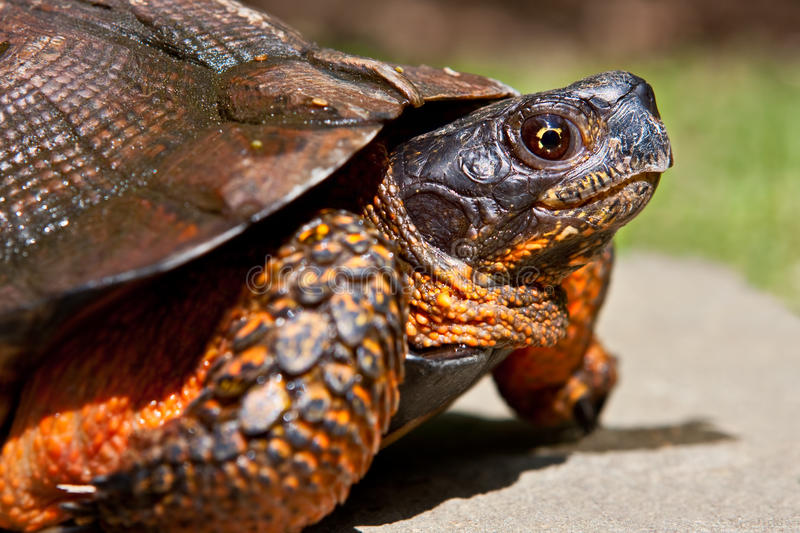ANIMAL: Wood Turtle Glyptemys insculpta Type of Animal: Turtle Habitat: Slow/moderate flowing streams/rivers/creeks w/ sandy/soft/gravel bottom, heavily vegetated banks, & muddy shores, bogs, farm fields, wet meadows, beaver ponds, woodland, forest, rocky stream courses, grassland, shrub/berry thickets, swamps, woodland/forest openings & edges, logs/banks near water, farmland, most often in cool upland areas, wetlands, roadsides, prairie, sand banks Location(s): Parts of S Ontario, S Quebec, Nova Scotia, New Brunswick, E US south to N Virginia & W to N Michigan, much of Wisconsin, E Minnesota, & parts of the E Iowa-Minnesota border Appearance: Rough tan/gray-brown/brown carapace (upper shell) w/ central ridge (keel) w/ pyramidal pattern of ridges/grooves, plastron (bottom shell) yellowish w/ dark patches, upper head surface dark gray to solid black, ventral surfaces of neck/chin/legs orange to red w/ faint yellow stripes along lower jaw of some individuals. Males have larger claws/head, concave plastron, domed carapace, & longer tails. Females/juveniles flat plastron, females pale yellow on neck/chin/inner legs while males more colored in these areas, hatchlings have dull gray to brown plastrons & less pyramidal carapaces. Food/Diet: Leaves/flowers of violets, strawberries, raspberries, willows, alders, birches, dandelions, cinquefoil, cranberry, milkweed, sorrel, greenbrier, plantain, & mullein, berries, fungi, slugs, snails, worms, crickets, beetles, moths, flies, ants, insect larvae, mice, eggs, carrion, crayfish, fruit (even pokeweed which can kill livestock), roots, tubers, algae, grasses, apple seeds, mosses, small birds, grubs, vegetables, corn, fish, leeches, frogs, spiders, millipedes, fox grapes, grapes, melons, roaches, sow bugs, grasshoppers, shrimp, small snakes Status in Wild: Endangered Conservation: Breeding in zoos, aquariums, & wildlife centers Lifestyle: Groups consist of dominant male, multiple females, & sometimes, 1-3 subordinate males. Additional Info: Called: Male Female Young-Hatchling Group-Bale Weight: Male-3 lbs Female-2 lbs Gestation: 2 months Life Span: 40 years Body Length: Male-8 in Female-7 in Young-1.5 in Tail Length: Male-7.86 in Female-7 in Young-1.5 in Main predators of adults are foxes, owls, coyotes, wolves, corvids, dogs, cats, bobcats, raccoons, otters, mink, snapping turtles, & weasels. Birds, opossums, skunks, chipmunks, largemouth bass, porcupines, snakes, & fly larvae eat young. Shrews eat eggs. Endangered due to pet trade, water pollution, habitat loss, industrial/residential development, & road mortality. Females lay 3-18 eggs. Sexually mature at 14-20 years. Fun Fact(s): They’re known to be adept escape artists & climbers. Some say they have the learning capacity of rats.
